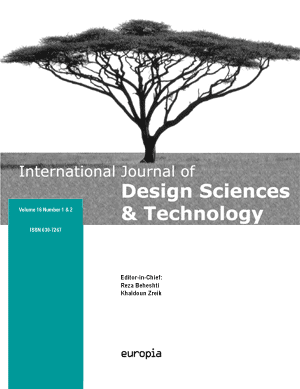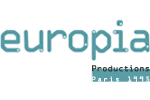International Journal
of
DESIGN
Sciences
&Technology
Editors:
Edwin DADO & Khaldoun ZREIK
(Journal empowered by the CNU 71e and the HCERES in SIC since 2016)
(Revue habilitée par le CNU 71e et l'HCERES en SIC depuis 2016)
IJDST
ISSN
1630-7267
- Introduction
- Editorial Board
- Editors
- Submission
- Topics
- Subscription
- Volumes Acquisition
- Issue Acquisition
- Contact

Aims and scope
Today’s design strongly seeks ways to change itself into a more competitive and innovative discipline taking advantage of the emerging advanced technologies as well as evolution of design research disciplines with their profound effects on emerging design theories, methods and techniques. A number of reform programmes have been initiated by national governments, research institutes, universities and design practices. Although the objectives of different reform programmes show many more differences than commonalities, they all agree that the adoption of advanced information, communication and knowledge technologies is a key enabler for achieving the long-term objectives of these programmes and thus providing the basis for a better, stronger and sustainable future for all design disciplines. The term sustainability - in its environmental usage - refers to the conservation of the natural environment and resources for future generations. The application of sustainability refers to approaches such as Green Design, Sustainable Architecture etc. The concept of sustainability in design has evolved over many years. In the early years, the focus was mainly on how to deal with the issue of increasingly scarce resources and on how to reduce the design impact on the natural environment. It is now recognized that “sustainable” or “green” approaches should take into account the so-called triple bottom line of economic viability, social responsibility and environmental impact. In other words: the sustainable solutions need to be socially equitable, economically viable and environmentally sound.
IJDST promotes the advancement of information and communication technology and effective application of advanced technologies for all design disciplines related to the built environment including but not limited to architecture, building design, civil engineering, urban planning and industrial design. Based on these objectives the journal challenges design researchers and design professionals from all over the world to submit papers on how the application of advanced technologies (theories, methods, experiments and techniques) can address the long-term ambitions of the design disciplines in order to enhance its competitive qualities and to provide solutions for the increasing demand from society for more sustainable design products. In addition, IJDST challenges authors to submit research papers on the subject of green design. In this context “green design” is regarded as the application of sustainability in design by means of the advanced technologies (theories, methods, experiments and techniques), which focuses on the research, education and practice of design which is capable of using resources efficiently and effectively. The main objective of this approach is to develop new products and services for corporations and their clients in order to reduce their energy consumption.
The main goal of the International Journal of Design Sciences and Technology (IJDST) is to disseminate design knowledge. The design of new products drives to solve problems that their solutions are still partial and their tools and methods are rudimentary. Design is applied in extremely various fields and implies numerous agents during the entire process of elaboration and realisation. The International Journal of Design Sciences and Technology is a multidisciplinary forum dealing with all facets and fields of design. It endeavours to provide a framework with which to support debates on different social, economic, political, historical, pedagogical, philosophical, scientific and technological issues surrounding design and their implications for both professional and educational design environments. The focus is on both general as well as specific design issues, at the level of design ideas, experiments and applications. Besides examining the concepts and the questions raised by academic and professional communities, IJDST also addresses the concerns and approaches of different academic, industrial and professional design disciplines. IJDST seeks to follow the growth of the universe of design theories, methods and techniques in order to observe, to interpret and to contribute to design's dynamic and expanding sciences and technology. IJDST will examine design in its broadest context. Papers are expected to clearly address design research, applications and methods. Conclusions need to be sufficiently supported by both evidence from existing research (reference to existing design research knowledge) as well as strong case-studies from any design discipline. A paper must contain at least one chapter on research questions, methodology of research and methods of analysis (the minimum length is 1500 words). The concluding chapter (the minimum length is 1000 words) will summarise the paper and its results. The concluding chapter also examines and discuss applications, advantage, shortcomings and implications of the investigation for both professional and educational design communities as well as for the people and the society. Also authors are also encouraged to include in this chapter a discussion of the possible future research that is required or is possible in order to enhance the research findings.
The papers considered for IJDST cover a wide range of research areas including but not limited to the following topics: Design research, design science, design thinking, design knowledge, design history, design taxonomy, design technology, design praxeology, design modelling, design metrology, design axiology, design philosophy, design epistemology, design pedagogy, design management, design policy, design politics, design sociology, design economics, design aesthetics, design semantics, design decision-making, design decisions, design evaluation, design sustainability, design logic, design ontology, design logistics, design syntaxis, design ethics, design objective, design responsibility, design environment, design awareness, design informatics, design organization, design communication, design intelligence, design evaluation, design education, design theories, design techniques, design methods, design operations, design processes, design products, design users, design participation, design innovation, design inspired by nature, design case studies, design experiments, etc.
International Journal of Design Sciences and Technology is devoted to further exploration of all themes and issues that are directly or indirectly relevant to the exploration, introduction, discussion of design sciences and technology, cross-referencing domains and any other themes emerging in the future..
IJDST is available on digital format since Volume 14 N1

